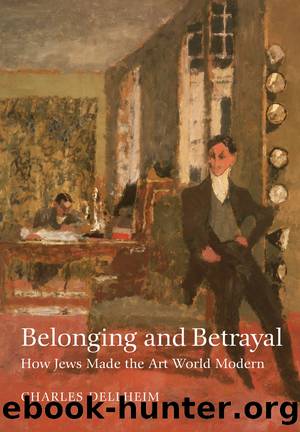Belonging and Betrayal by Charles Dellheim

Author:Charles Dellheim [Dellheim, Charles]
Language: eng
Format: epub
ISBN: 9781684580576
Publisher: Brandeis University Press
INNOVATION MAY TAKE place on the margins, but it may die there, too, the victim of conventional prejudice or bad management. This is what Paul Rosenberg had to prevent. Much as Rosenberg moved Picasso from bohemian to bourgeois Paris, he was determined to move modern art from the periphery to the center. His gallery was, in this regard, an engine for cultural transformation as well as commercial traffic. And in the âmarket for love,â its proprietor acquitted himself with flair and distinction.
His efforts paid off. âJust as one went to rue Lafitte to go to the exhibitions at the Durand-Ruel gallery,â Vollard observed, âtoday one goes to see what Paul Rosenberg has to offer.â4 The gallery window, which tended to display only a few objects here or there, offered only a hint of the vast storehouse of art that lay within 21, rue la Boétie.
During the 1920s, Paul Rosenberg greatly enriched his offerings, his reach, and his standing by adding important artists to his gallery. In 1924, Braque left Kahnweiler in search of more vigorous promotion and better results. The violent disagreement he had had at the Hôtel Drouot three years before with one Rosenberg did not stop Braque from throwing in his lot with another. With Braque as with Picasso, Paul Rosenberg required only âright of first refusal.â Thus, the cocreators of cubism were once more united under one banner as they had been in their glory days before la Grande Guerre.
Paul benefited, too, from an assist from Léonce. When Léonce finally realized that Léger was going to leave the Galerie de lâEffort Moderne one way or the other, he reconciled himself to the idea that it was better to keep him in the family than see him leave the fold entirely. In May 1925, then, he arranged to introduce Léger to his enviably successful younger brother, however disappointed he was by yet another key defection. He cautioned the artist not to talk to Paul about Kahnweiler because he would immediately answer (as Léonce would in his place), that if Léger thinks âK. is worth more than a Rosenberg, you wouldnât be in front of me today.â5 Duly warned and properly introduced, Léger moved from one Rosenberg to another. And Paul Rosenberg began offering the machine-age productions of Léger along with the altogether softer lines of Marie Laurencinâs portraits.
Rosenberg displayed his artistsâ works in a setting that looked anything but ascetic. Its elaborate design and décor took hold of visitors whether they liked it or not. Academician Jacques-Ãmile Blanche pronounced the Galerie Paul Rosenberg a âPalace.â This might have been a compliment in some peopleâs books but was definitely nothing of the sort in his. The gallery had a façade made entirely of marble, a vestibule made of marble, and a staircase made of onyx. Its vast rooms were hung with watered silk. âTorrents of light, Blanche observed, cascade from an ingeniously shaped ceiling fixture in which dozens of bulbs hang like grapes on the vine.â6
In its contents and
Download
This site does not store any files on its server. We only index and link to content provided by other sites. Please contact the content providers to delete copyright contents if any and email us, we'll remove relevant links or contents immediately.
Cecilia; Or, Memoirs of an Heiress — Volume 1 by Fanny Burney(31339)
Cecilia; Or, Memoirs of an Heiress — Volume 3 by Fanny Burney(30936)
Cecilia; Or, Memoirs of an Heiress — Volume 2 by Fanny Burney(30892)
The Secret History by Donna Tartt(16635)
Sapiens: A Brief History of Humankind by Yuval Noah Harari(13061)
Leonardo da Vinci by Walter Isaacson(11907)
The Radium Girls by Kate Moore(10910)
Sapiens by Yuval Noah Harari(4542)
The Wind in My Hair by Masih Alinejad(4426)
How Democracies Die by Steven Levitsky & Daniel Ziblatt(4401)
Homo Deus: A Brief History of Tomorrow by Yuval Noah Harari(4282)
Endurance: Shackleton's Incredible Voyage by Alfred Lansing(3847)
The Silk Roads by Peter Frankopan(3764)
Man's Search for Meaning by Viktor Frankl(3637)
Millionaire: The Philanderer, Gambler, and Duelist Who Invented Modern Finance by Janet Gleeson(3573)
The Rape of Nanking by Iris Chang(3518)
Hitler in Los Angeles by Steven J. Ross(3440)
The Motorcycle Diaries by Ernesto Che Guevara(3338)
Joan of Arc by Mary Gordon(3260)
